Sarah Emsley's Blog, page 3
June 20, 2025
“She changed my life”: Andrew Davies pays tribute to Jane Austen
“I have a particular reason for feeling grateful to Jane Austen,” says screenwriter Andrew Davies, who has adapted Pride and Prejudice, Emma, Northanger Abbey, Sense and Sensibility, and Sanditon for television, and Pride and Prejudice and Emma for the stage. Quite simply, he writes, “She changed my life.” In the tribute he wrote for “Unexpectedly Austen,” the series Liz Philosophos Cooper and I are co-editing for the Jane Austen Society of North America in honour of Austen’s 250th birthday, Davies adds that he is “currently having a sniff around The Watsons.”

Our June installment of “Unexpectedly Austen” also includes two more tributes written specifically for this series, from Paul Gordon and Gay Mohrbacher. Gordon writes that when he was creating a musical version of Emma, he felt it was a “secret collaboration with the author herself.” Mohrbacher speaks of how much she and her colleagues at PBS have enjoyed bringing adaptations of Austen’s novels to the small screen: “Bonnets off to Jane!”
You can read these tributes in full, along with all the other installments in the series, on the “Unexpectedly Austen” page on the JASNA website.
I’m excited about this year’s JASNA AGM in Baltimore, “Austen at 250: ‘No check to my Genius from beginning to end,’” October 10-12, 2025. (Registration for the AGM opened yesterday, and I believe it is already full, though there is a waitlist.) I’m looking forward to hearing talks by many Austen scholars, including contributors to the blog series celebrations of Austen’s novels that I’ve hosted here over the past several years (Devoney Looser, Collins Hemingway, Kim Wilson, Elaine Bander, Susan Allen Ford, Hazel Jones, Theresa Kenney, and Nili Olay).
At the AGM, I’ll be speaking about “Books as Children,” providing an overview of the tradition of connecting the creation of art with the creation of human life and analyzing Austen’s references to P&P and S&S as her “children” in the context of her development as a writer, her experiences with publication, and her relationships with family members—especially her sisters-in-law, who experienced the risks and challenges of motherhood as well as its joys.

Jane Austen referred to Pride and Prejudice as her “own darling Child” and said of Sense and Sensibility that she could “no more forget it, than a mother can forget her sucking child”
Those of you who are L.M. Montgomery fans will, I think, be interested to know that Nili Olay will be speaking at the AGM about “Austen at 250 and Montgomery at 150: A Century Apart and Still Going Strong.” You may recall that Nili wrote about her experience of “Discovering Anne of Green Gables in Tel Aviv” for my LMM series last fall.
I’ll end today’s post with photos from the Garden Party at Government House in Halifax, an annual event that is free and open to the public. This year it was held on June 18th, and the theme was a celebration of the 60th anniversary of the National Flag of Canada.


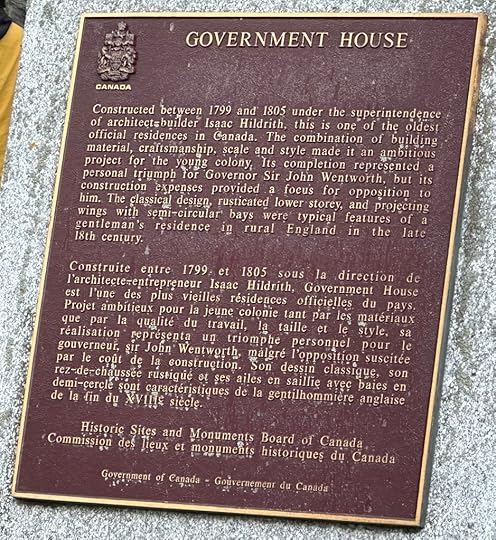

If I had known my friends from JASNA were going to be at the Lieutenant Governor’s Garden Party, I would have worn my Regency gown . . .
If you enjoyed this post, I hope you’ll consider recommending it to a friend. If you aren’t yet a subscriber, please sign up.
Here are the links to the last two posts, in case you missed them:
Celebrating Jane Austen’s 250th Birthday at St. Paul’s Church, Halifax
From Alton to Chawton (photos taken on a walk from the train station in Alton to Jane Austen’s House Museum in Chawton)
Read more about my books, including St. Paul’s in the Grand Parade, Jane Austen’s Philosophy of the Virtues, and Jane Austen and the North Atlantic, here.
Copyright Sarah Emsley 2025 ~ All rights reserved. No AI training: material on http://www.sarahemsley.com may not be used to “train” generative AI technologies.
June 13, 2025
Celebrating Jane Austen’s 250th Birthday at St. Paul’s Church, Halifax
The Jane Austen Birthday Tea at St. Paul’s last Saturday was delightful. Many people attended in period costume, we heard lots of compliments about the event, the music, and the food, and I enjoyed talking about the connections between the Austen family and St. Paul’s. It was fun to introduce several members of the parish, who took on the roles of Mr. and Mrs. Bennet, Lady Catherine de Bourgh, Captain Wentworth, and other Austen characters and read brief excerpts from the novels.

“Mr. and Mrs. Bennet” with their son and his family (and me)

Siblings Tessa and Sean Sneddon provided music during the Tea
Many thanks to Margaret Bateman Ellison (pictured here with her husband), who organized the Jane Austen Tea and the other 275th anniversary weekend events, and to all the volunteers who contributed to this wonderful celebration.
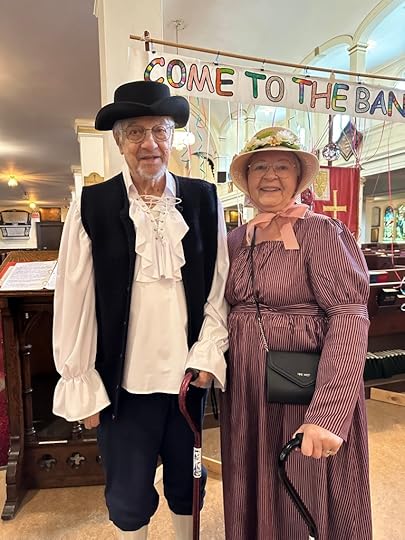

The Open House earlier in the day on Saturday included tables with information about the Jane Austen Society of North America (JASNA), the Titanic Society of Atlantic Canada (and connections between St. Paul’s and Titanic), and the role played by St. Paul’s in the relief efforts after the Halifax Explosion. We also had a book table for St. Paul’s Church at 275 and my book St. Paul’s in the Grand Parade. Some of the other tables featured information about the Old Burying Ground Foundation, St. Paul’s Home, and the oldest Sunday School in Canada, along with a variety of outreach programs such as the weekly Rector’s Lunch.

JASNA table

Titanic Society of Atlantic Canada table
One of the many people who came to the Open House was my grade five teacher, Betty McOnie, who encouraged and inspired me to write when I was ten and continues to do so now. I feel very fortunate to have had Mrs. McOnie as a teacher and to have reconnected with her in recent years.

Mrs. McOnie and me
Two of the events from the 275th anniversary weekend at St. Paul’s are available to watch on YouTube:
A Sunday service with the 1662 Book of Common Prayer, which our ancestors would have used when St. Paul’s opened for worship in 1750.
A Friday evening event with music and reflections on the history of the beautiful stained glass windows at St. Paul’s.
Two more photos for today: the first is of me with Adriel Driver, who played the role of Lady Catherine, and the second is of four of us from JASNA’s Nova Scotia Region. In all the years I’ve been a member of JASNA (more than a quarter of a century), I had never worn period costume—but this was the day for the new Regency gown I bought at the JASNA AGM last fall, and I was very happy with it!
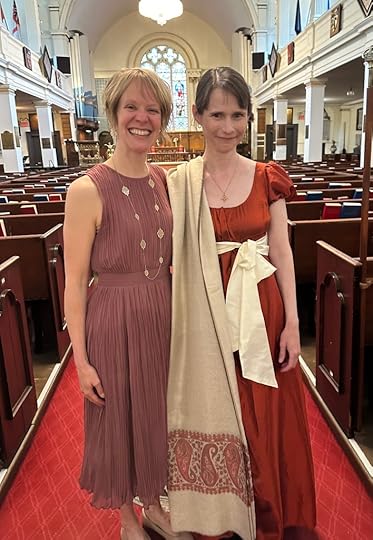

If you enjoyed this post, I hope you’ll consider recommending it to a friend. If you aren’t yet a subscriber, please sign up.
Here are the links to the last two posts, in case you missed them:
From Alton to Chawton (photos taken on a walk from the train station in Alton to Jane Austen’s House Museum in Chawton)
St. Paul’s Church Open House and Jane Austen Birthday Tea
Read more about my books, including St. Paul’s in the Grand Parade, Jane Austen’s Philosophy of the Virtues, and Jane Austen and the North Atlantic, here.
Copyright Sarah Emsley 2025 ~ All rights reserved. No AI training: material on http://www.sarahemsley.com may not be used to “train” generative AI technologies.
June 6, 2025
From Alton to Chawton
When we were in England earlier in the spring, my daughter and I walked to Jane Austen’s House Museum in Chawton from the Alton train station, following directions posted on the JAHM website.
I thought I’d share with you just a few of the landmarks we passed:

The Crown Hotel, which was owned by Jane’s brother Edward

Henry Austen’s bank

The Butts, historically the boundary between Alton and Chawton; site of archery practice

Chawton
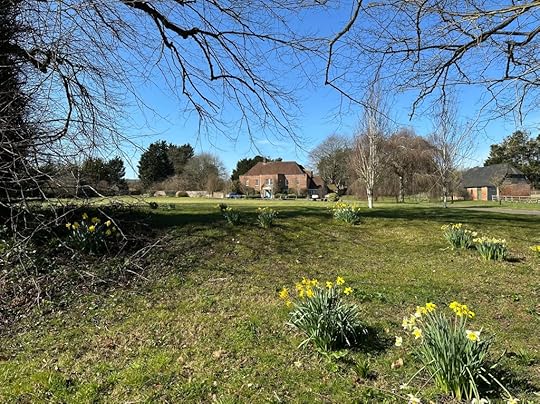
Prowtings, home of the Prowting family, who are mentioned several times in Jane Austen’s letters
In my novel The Austens, Jane and members of her family often walk between Chawton and Alton, and I enjoyed retracing their steps after having spent so much time on these roads and paths in my imagination while writing the book.
I shared photos of our day at Jane Austen’s House Museum here, and I’ll share some photos from our visit to Chawton House in a future post.
On a different topic: I’m delighted with the current window display at Bookmark II on Spring Garden Road in Halifax. It features the new book St. Paul’s Church at 275, with essays by Alison Kitt-Grainger and Aidan Ingalls, and the very old book St. Paul’s in the Grand Parade written by me way back in 1999. Thank you to the staff for putting together this beautiful display in honour of the 275th anniversary celebrations this weekend at St. Paul’s.
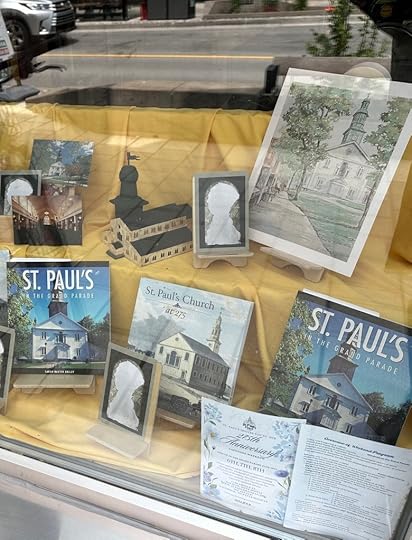

I believe there are still tickets ($25 each) available for the Jane Austen 250th Birthday Tea, with sittings at 2:00 p.m. and 4:00 p.m. Tickets are available from the parish office. I’m organizing and hosting a short program of readings from Austen’s novels, and I think the event will be fun.

As I mentioned in last week’s post, all are welcome to attend the weekend events, all of which are free with the exception of the Tea. More information on the poster below or on the church’s website.

If you enjoyed this post, I hope you’ll consider recommending it to a friend. If you aren’t yet a subscriber, please sign up.
Here are the links to the last two posts, in case you missed them:
St. Paul’s Church Open House and Jane Austen Birthday Tea
Natalie Jenner on Jane Austen as a source of “sustenance, resilience, and hope”
Read more about my books, including St. Paul’s in the Grand Parade, Jane Austen’s Philosophy of the Virtues, and Jane Austen and the North Atlantic, here.
Copyright Sarah Emsley 2025 ~ All rights reserved. No AI training: material on http://www.sarahemsley.com may not be used to “train” generative AI technologies.
May 30, 2025
St. Paul’s Church Open House and Jane Austen 250th Birthday Tea
St. Paul’s, the oldest building in Halifax, Nova Scotia, and the oldest existing Anglican place of worship in Canada, is hosting several events on the June 6 – 8 weekend to celebrate the church’s 275th anniversary, including a Jane Austen Tea on Saturday, June 7th.

All are welcome to attend the celebrations, and most of the events are free. Tickets for the Jane Austen Tea are $25 and can be booked through the parish office. There will be two sittings, one at 2:00 p.m. and one at 4:00 p.m. Attending in period costume is encouraged (but not required). More details are available on the St. Paul’s website and the poster below.
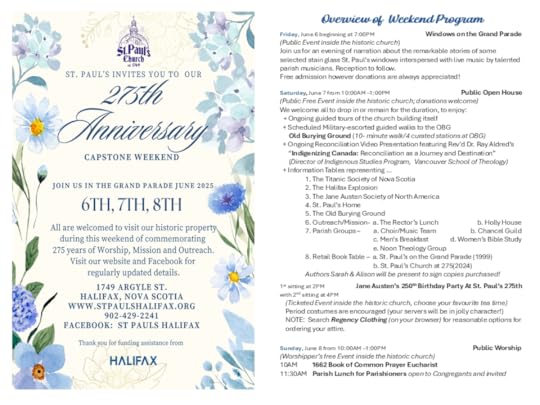
I think it’s wonderful that these significant anniversaries overlap. St. Paul’s started celebrating in 2024, the 275th anniversary of the date the parish was founded, and the celebrations are continuing in 2025, the 275th anniversary of the date the building opened. Jane Austen’s 250th birthday is on December 16, 2025, and readers and fans around the world are celebrating throughout this anniversary year.
Regular readers will have heard me talk about the connections between Jane Austen and this historic church on more than one occasion! Austen’s niece Cassy Austen was baptized at St. Paul’s in 1809, and her nephew Charles John Austen, Jr., was married there in 1848. (Read more about the Austen family’s connections with Halifax, Nova Scotia here.)
At the Jane Austen Tea on June 7th, music will be provided by members of the parish. I’ll speak about the Austen connection with the church and introduce readers who’ll share passages from Austen’s works.
Please join us for tea and a joyful birthday party!

(I took this photo of roses in front of St. Paul’s last November.)
The Open House, earlier in the day on Saturday, June 7th (between 10:00 a.m. and 1:00 p.m.), will include guided tours and information tables hosted by several groups, including the Jane Austen Society of North America’s Nova Scotia Region and the Titanic Society of Atlantic Canada. Also on offer is a video presentation by The Rev’d Dr. Raymond Aldred, Director of the Indigenous Studies Program at the Vancouver School of Theology, who spoke at St. Paul’s last year. The video is entitled “Indigenizing Canada: Reconciliation as a Journey and Destination.”
Other events include an evening of reflections on the history of the stained glass windows at St. Paul’s, on Friday, June 6th at 7:00 p.m., and a 1662 Book of Common Prayer service on Sunday, June 8th at 10:00 a.m.
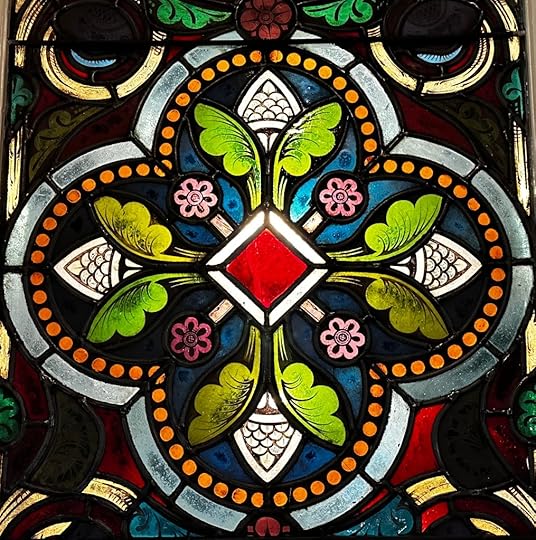
Detail of the oldest stained glass window at St. Paul’s Church, installed in 1872

I photographed the famous Halifax Explosion Window in the gallery of St. Paul’s last fall, when I was preparing a slideshow for my talk at Government House, and I recently helped produce a postcard featuring this image. As a result of the explosion on December 6, 1917, the window broke in this unusual shape. Many ghost stories have been told about it over the years because it resembles the profile of a person. The broken glass was preserved between two new panes of glass, and the window continues to fascinate visitors to the church.
Come and learn about the rich and complex history of this remarkable place!
Some of you might also be interested to watch this interview I did last week for “The Author Journey,” hosted by Anne Louise O’Connell. We had a fun conversation, in which Anne asked me questions about my book St. Paul’s in the Grand Parade, Jane Austen’s 250th, and other topics.
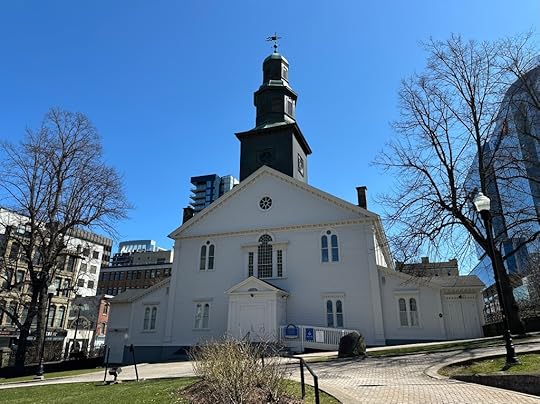
If you enjoyed this post, I hope you’ll consider recommending it to a friend. If you aren’t yet a subscriber, please sign up.
Here are the links to the last two posts, in case you missed them:
Natalie Jenner on Jane Austen as a source of “sustenance, resilience, and hope”
Read more about my books, including St. Paul’s in the Grand Parade, Jane Austen’s Philosophy of the Virtues, and Jane Austen and the North Atlantic, here.
Copyright Sarah Emsley 2025 ~ All rights reserved. No AI training: material on http://www.sarahemsley.com may not be used to “train” generative AI technologies.
May 23, 2025
Natalie Jenner on Jane Austen as a source of “sustenance, resilience, and hope”
“I don’t know if any author has ever been more influenced by Jane Austen, or more personally indebted. When my husband was diagnosed in 2017 with a rare and deadly lung disease, the only books I could read were hers. When life somewhat stabilized, I took a solo trip to Chawton so that I could walk in Austen’s footsteps and thank her for helping me through such a difficult time.”
The May installment of “Unexpectedly Austen,” the series Liz Philosophos Cooper and I are co-editing this year in honour of Jane Austen’s 250th birthday, features internationally bestselling author Natalie Jenner’s reflections on what Austen means to her. She writes of finding “sustenance, resilience, and hope” in Jane Austen’s world.
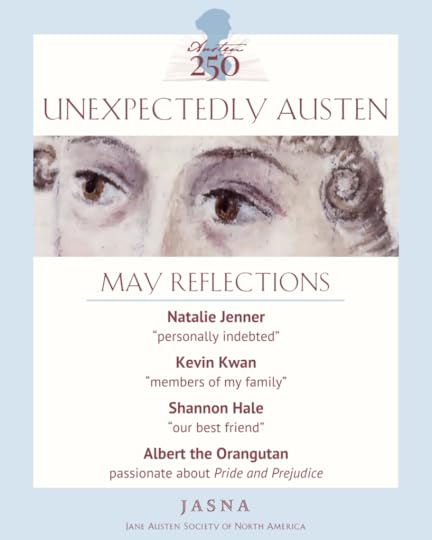
Natalie is the author of The Jane Austen Society, Bloomsbury Girls, and Every Time We Say Goodbye, and her new novel, Austen at Sea, was published earlier this month—congratulations, Natalie! Last summer, I had the privilege of sharing a first glimpse of a chapter from Austen at Sea here, as part of my Summer Party for Sense and Sensibility.

You can read Natalie Jenner’s reflections in full on the Jane Austen Society of North America website. The May installment of “Unexpectedly Austen” also includes quotations from Kevin Kwan, author of Crazy Rich Asians, who says that in reading Austen’s novels he felt as if he were reading about members of his own family, and Shannon Hale, author of Austenland, who writes that “Whenever we’re reading her books, we shamelessly claim Jane Austen as our best friend.” This month, we’re also featuring the story of Albert the orangutan, a passionate fan of Pride and Prejudice. Michael Krause of Gdansk Zoo in Poland describes reading the novel aloud at bedtime to help Albert go to sleep.
Read all the tributes and quotations posted to date on the “Unexpectedly Austen” page: from Anna Quindlen and Dwyane Wade (January); Adjoa Andoh and John Mullan (February); Jeanne Birdsall, Taylor Swift, Ian McEwan, and Margaret Drabble (March); and George Elliott Clarke, Taylor Jenkins Reid, and Azar Nafisi (April).
I’ll end today’s post with photos of a delightful Yellow Warbler in the Annapolis Valley and spring blooms in the Historic Gardens in Annapolis Royal, Nova Scotia. These were taken recently by Brenda Barry and are included here with her permission.
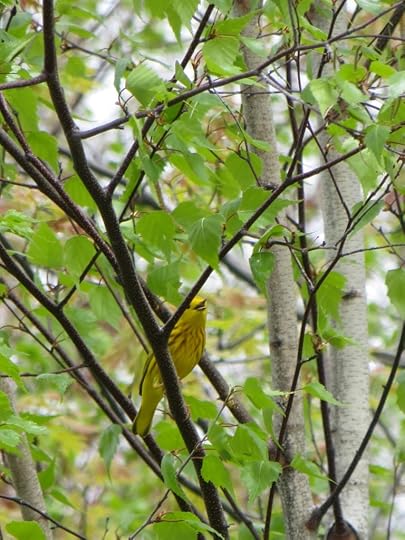

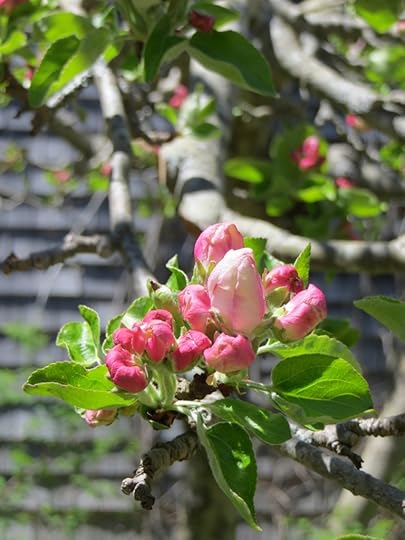

If you enjoyed this post, I hope you’ll consider recommending it to a friend. If you aren’t yet a subscriber, please sign up.
Here are the links to the last two posts, in case you missed them:
“A sunny Nova Scotia May day” (Budge Wilson’s short story “The Leaving” and the Halifax Public Gardens)
Read more about my books, including St. Paul’s in the Grand Parade, Jane Austen’s Philosophy of the Virtues, and Jane Austen and the North Atlantic, here.
Copyright Sarah Emsley 2025 ~ All rights reserved. No AI training: material on http://www.sarahemsley.com may not be used to “train” generative AI technologies.
May 16, 2025
My debut novel, The Austens
I’m thrilled to share the news that my novel The Austens will be published by Pottersfield Press this fall! I hope very much that you’ll enjoy reading it.

In my novel, Jane Austen chooses art and the freedom to write fiction instead of marrying for money and thereby selling her body and soul, while her sister-in-law Fanny chooses to marry for love. Their disagreements about work and family threaten their friendship in a world that is hostile to art and love, and even the idea of a woman making a choice.

I’ve received some wonderful endorsements for The Austens, for which I am deeply grateful. I’ll share them here with you over the coming months. I’m also excited to share the beautiful cover of the novel, along with information about the launch and other readings and events.
In Bermuda one young woman chooses love and suffers relentless child-bearing; in England her sister-in-law opts for authorship within a female household. In this powerful reimagining of the stories of Fanny Palmer and Jane Austen, Sarah Emsley creates a rich and poignant context for the six novels—a context that lets us see what Austen reveals of women’s lives—and how much she omits.
– Janet Todd, author of Living with Jane Austen and Jane Austen and Shelley in the Garden
Sarah Emsley is a gifted writer who brings her witty Jane Austen to such vibrant life, you will feel as though you are hearing the famous author’s actual thoughts and reading her real journals and letters. … Brimming with intelligence, empathy, and pathos, The Austens will linger in your mind long after you have turned the last page.
– Syrie James, international bestselling author of The Lost Memoirs of Jane Austen, The Missing Manuscript of Jane Austen, and Jane Austen’s First Love
Pottersfield Press has published books by many writers I admire, including Brian Bartlett, George Elliott Clarke, Sheree Fitch, Steven Laffoley, Frank MacDonald, Marjorie Simmins, Jon Tattrie, Margo Wheaton, and Budge Wilson, and it will be an honour to see my book alongside theirs. I’m pleased that this novel, which was inspired by Jane Austen’s connection with my hometown of Halifax, will be published right here in Nova Scotia.
When the book is available for pre-order, I’ll share the details here so you’re the first to know. Pre-orders make such a difference because they give the publisher an indication of how much interest there is in the book. If you’re thinking you’ll buy The Austens at some point, I do hope you’ll consider ordering in advance.
I’m planning a big party here in Halifax for the launch of The Austens, and all are welcome. I hope many of you will come and celebrate with me—more on that soon! For now, please save the date and time: October 21st at 7pm.
I took this photo of Government House, Halifax, last fall. Fanny Austen and her husband Charles danced at a ball at Government House in 1810—and I’ve brought that evening to life in a scene in my novel. Can’t wait to share it with you!

If you’re on social media, you can find me on Facebook, Instagram, Bluesky Social, LinkedIn, Goodreads, and Pinterest.
If you enjoyed this post, I hope you’ll consider recommending it to a friend. If you aren’t yet a subscriber, please sign up.
Here are the links to the last two posts, in case you missed them:
“A sunny Nova Scotia May day” (Budge Wilson’s short story “The Leaving” and the Halifax Public Gardens)
Read more about my books, including St. Paul’s in the Grand Parade, Jane Austen’s Philosophy of the Virtues, and Jane Austen and the North Atlantic, here.
Copyright Sarah Emsley 2025 ~ All rights reserved. No AI training: material on http://www.sarahemsley.com may not be used to “train” generative AI technologies.
May 9, 2025
“A sunny Nova Scotia May day”
“The weather was dazzling—a sunny Nova Scotia May day. We walked through the huge iron gates into the Public Gardens and ate our sandwiches and apples beside the duck pond. I kicked off my rubber boots and wiggled my toes in the sun as I watched the swans and the yellow ducklings. The Gardens were immense, full of massive and intricate flowerbeds, winding paths, and strange exotic trees. There were statues, a splashing fountain, an elaborate round bandstand, and a little river with a curved bridge over it. Lovers strolled arm in arm, and children shrieked with laughter as they chased the pigeons.”
– Budge Wilson, “The Leaving”

Last week when I was walking through the Halifax Public Gardens, I was thinking about this passage from Budge Wilson’s brilliant short story “The Leaving,” which paints such a clear and beautiful picture of springtime in the Gardens. The narrator of the story asks her mother why everyone in the Gardens seems so happy. “‘Dunno,’ she said. ‘Weather does things t’ people.’ She looked around. ‘And maybe some of them’s free,’ she added.”

May 2, 2025 would have been Wilson’s 98th birthday. Six years ago, on May 2, 2019, our Project Bookmark Canada Nova Scotia Reading Circle hosted a birthday party for her at Woozles, where several people read passages from her work, including a longer version of this excerpt from “The Leaving,” and Budge herself read one of her poems.
If you’d like to see photos from the party (including one of my daughter presenting Budge Wilson with a bouquet of red tulips), you can find them here.
We’re continuing to work toward a Budge Wilson Bookmark plaque in Halifax, and when the details are confirmed, I’ll be sure to share the news here. If you’re interested, you can read more about Project Bookmark Canada on their website and about our Nova Scotia Reading Circle here. Join our Facebook group for updates.
Speaking of the Halifax Public Gardens, I’m also helping to organize a celebration of Jane Austen’s 250th birthday in the Gardens this summer, and I’ll write more about that event soon, along with details about some other exciting events coming up later this year! Next week, I’ll share some news about a project that’s especially close to my heart….
In the meantime, I’ll leave you with more photos from that dazzling May day in the Gardens.
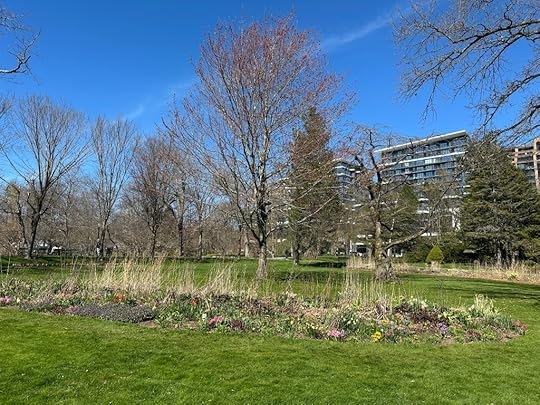

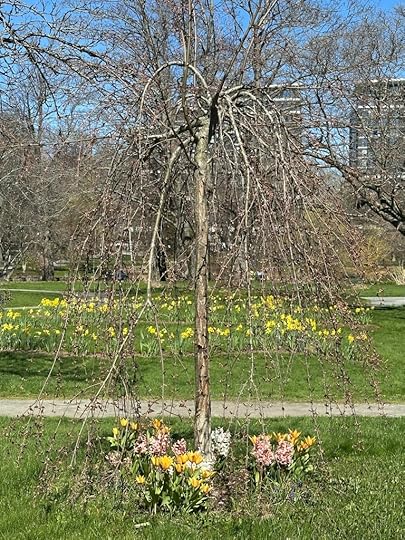


If you enjoyed this post, I hope you’ll consider recommending it to a friend. If you aren’t yet a subscriber, please sign up.
Here are the links to the last two posts, in case you missed them:
George Elliott Clarke: “Jane Austen is deathless”
Read more about my books, including St. Paul’s in the Grand Parade, Jane Austen’s Philosophy of the Virtues, and Jane Austen and the North Atlantic, here.
Copyright Sarah Emsley 2025 ~ All rights reserved. No AI training: material on http://www.sarahemsley.com may not be used to “train” generative AI technologies.
May 2, 2025
A Poem Every Morning
Inspired by a recent blog post by my friend Renée Hartleib, I’ve started to read one or two poems first thing in the morning, before I read the news. I used to do this years ago and am grateful to Renée for the reminder of how rewarding this habit can be. I decided to use one of my (many) blank notebooks to record lines of poetry I want to remember.

I chose this one (a birthday present from a friend), which features art by Mi’kmaw artist Alan Syliboy
Renée writes, “My partner and I light a candle each morning and read aloud from Mary Oliver’s book Devotions, a collection of her poetry over her entire lifetime (and one that she curated herself). This simple act returns me to the world of beautiful words and their power, plus Oliver wrote almost exclusively about the sacredness of nature and how it can inspire us to lead lives of more simplicity and grace.”
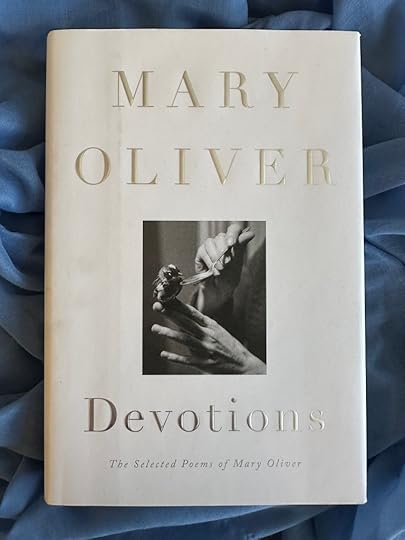
I like what Oliver says about Queen Anne’s lace in “Passing the Unworked Field”: she writes that “Queen Anne’s lace / is hardly / prized,” yet she asks us to pay attention to the ways in which it “makes all the / loveliness / it can.”
I’ve also recorded phrases and lines from the Good Friday poems my father and I read at St. Paul’s Church a couple of weeks ago, including “thick depriving darknesses” and “images of self-confusednesses” from Fulke Greville’s “In night” and the opening lines of Helen Pinkerton’s “Subjectivity” (published in Taken in Faith):
I measure years by days and days by hours
But in the elastic hour of calculation
I leave immeasurable the instrument.
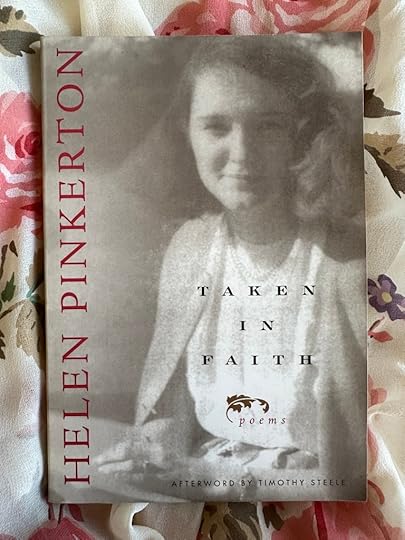
(If you’d like to watch the video of the service, you can find it here here.)
My friend Shawna Lemay wrote an eloquent tribute to Poetry Month:
May your life become poetry this month in the name of all those whose lives have been lost, whose lives have become harder than they needed to become, who are living with grief, who are afraid and anxious, who are living with unimaginable difficulties.
Even though April has ended, let’s continue to honour poetry in May and every month. I’d be glad to hear your recommendations about favourite poems and poets, if you feel inclined to share them in the comments.
If you enjoyed this post, I hope you’ll consider recommending it to a friend. If you aren’t yet a subscriber, please sign up.
Here are the links to the last two posts, in case you missed them:
George Elliott Clarke: “Jane Austen is deathless”
Read more about my books, including St. Paul’s in the Grand Parade, Jane Austen’s Philosophy of the Virtues, and Jane Austen and the North Atlantic, here.
Copyright Sarah Emsley 2025 ~ All rights reserved. No AI training: material on http://www.sarahemsley.com may not be used to “train” generative AI technologies.
April 25, 2025
George Elliott Clarke: “Jane Austen is deathless”
“Jane Austen is deathless; I mean, she is as continuously relevant as scripture because she posits—as indelibly as do Platonists and patriarchs—that the sustenance of a civilization depends on how the sexes come to mate and propagate the next generation—via love, lust, and/or lucre.”
George Elliott Clarke, poet, novelist, opera librettist, playwright, and former Canadian Parliamentary Poet Laureate, wrote a tribute to Jane Austen for “Unexpectedly Austen,” the series I’m co-editing with Liz Philosophos Cooper this year as part of the celebrations of Austen’s 250th birthday.

Clarke writes that “In authoring The Motorcyclist (2016), a novel based on my late father’s diary-recorded amours of 1959, the year of my conception, I soon saw that Austen’s staging of class-conflicted coitus had to drive my story about a Black Haligonian railway worker and wanna-be artist employing his BMW motorcycle, dubbed ‘Elizabeth II,’ to entice various gals into ‘deliciously’ compromising positions.” Read his tribute in full on the JASNA website.

This month’s installment of “Unexpectedly Austen” also includes quotations from Taylor Jenkins Reid, author of Daisy Jones and the Six and other bestselling novels, and award-winning author Azar Nafisi, best known for Reading Lolita in Tehran: A Memoir in Books. Reid says she is “ravenous for any adaptation or retelling” of Pride and Prejudice, while Nafisi says the story of Elizabeth Bennet and Mr. Darcy “proves the truth of the poet Ezra Pound’s claim that, ‘Literature is news that remains news.’”
You can find all the tributes and quotations posted to date on the “Unexpectedly Austen” page: from Anna Quindlen and Dwyane Wade (January); Adjoa Andoh and John Mullan (February); and Jeanne Birdsall, Taylor Swift, Ian McEwan, and Margaret Drabble (March).
On a different topic: if you were interested in last week’s post on Poems for Good Friday and would like to watch the video of the Good Friday Service at St. Paul’s Church, Halifax, you can find it here.
If you enjoyed this post, I hope you’ll consider recommending it to a friend. If you aren’t yet a subscriber, please sign up.
Here are the links to the last two posts, in case you missed them:
St. Paul’s Church, Halifax and RMS Titanic
Read more about my books, including St. Paul’s in the Grand Parade, Jane Austen’s Philosophy of the Virtues, and Jane Austen and the North Atlantic, here.
Copyright Sarah Emsley 2025 ~ All rights reserved. No AI training: material on http://www.sarahemsley.com may not be used to “train” generative AI technologies.
April 16, 2025
Poems for Good Friday
This Friday, April 18th, my father and I will be offering meditations at St. Paul’s Church, Halifax, NS (1749 Argyle St., across from City Hall). The Good Friday service begins at noon, and I’m sure the music will be wonderful. We’ll talk about poems by George Herbert, Fulke Greville, Janet Lewis, T.S. Eliot, and Helen Pinkerton. All are welcome.
St. Paul’s is the oldest existing Anglican place of worship in Canada and the oldest building in Halifax.
Read more about the schedule for Holy Week at St. Paul’s on the church’s website.
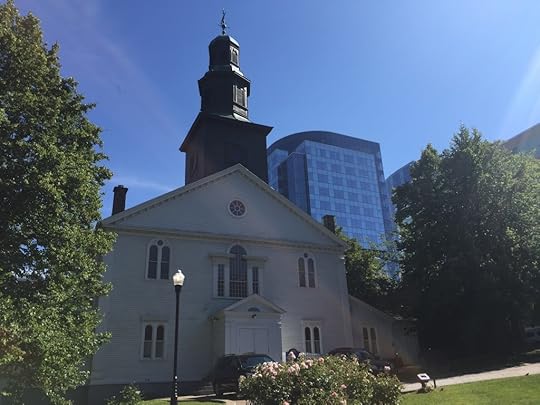
St. Paul’s Church, Halifax, Nova Scotia
I’ll also take this opportunity to say that longtime readers of my blog might remember my father’s contribution to the celebration I hosted in honour of the 200th anniversary of Jane Austen’s Mansfield Park:
“Fanny Price as a Student of Shakespeare,” by John Baxter
An excerpt:
. . . it seems plausible to assume that [Austen] deliberately chose [Henry VIII] because of a fundamental kinship between its heroine and the heroine of Mansfield Park. Both are women who may seem passive or inert from an external point of view, but who in reality are passionately devoted to their own deepest instincts and loyalties and who thus challenge the perspectives of the males in their circle.
At a general level, too, the play recommends itself because of its relentless investigation into the uses and abuses of power. Like Henry VIII, Mansfield Park presents a world in which love is hemmed in by a daunting array of powerful forces.
You can read the rest of the essay here.
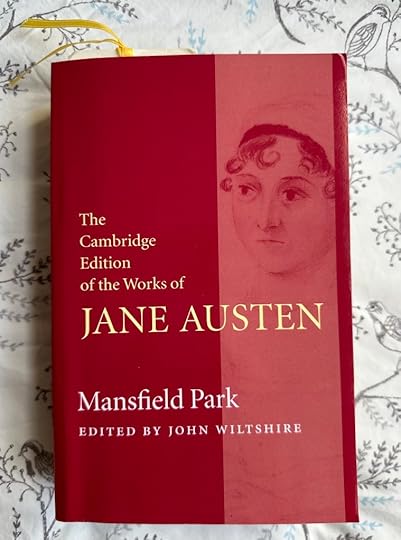
And if you happen to be in Halifax on Friday and would like to join us at St. Paul’s at 12pm, we’d be glad to see you there!
If you enjoyed this post, I hope you’ll consider recommending it to a friend. If you aren’t yet a subscriber, please sign up.
Here are the links to the last two posts, in case you missed them:
St. Paul’s Church, Halifax and RMS Titanic
A Glorious Spring Day at Jane Austen’s House in Chawton
Read more about my books, including St. Paul’s in the Grand Parade, Jane Austen’s Philosophy of the Virtues, and Jane Austen and the North Atlantic, here.
Copyright Sarah Emsley 2025 ~ All rights reserved. No AI training: material on http://www.sarahemsley.com may not be used to “train” generative AI technologies.



